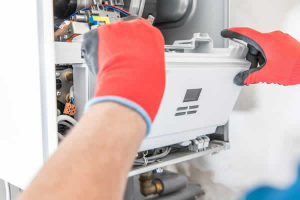
22 Jan, 2021
There’s nothing more frustrating than waking up to an icy house and realizing that instead of blowing in warmth, your heating system is pumping your home full of cold air or—worse—no air at all!
If you discover your furnace is not working, don’t panic. You can resolve many furnace malfunctions with some straightforward furnace troubleshooting.
Before contacting a repair professional, read on for our step-by-step guide to gas furnace troubleshooting and DIY solutions.
Modern furnaces are designed for reliability, but sometimes, they break down. To keep your furnace functioning properly, you should perform regular maintenance. However, even a properly cared for heating system can leave you in the cold.
If you find your furnace not working correctly, you can take a few steps to resolve the problem yourself before calling in a professional. You’ll need to know what kind of heating system you have and have a general idea of how it works. Then, you can determine what you’ll need to fix based on its symptoms. Once you’ve figured out the problem, you can try a simple DIY repair to get your furnace up and running again.
Before you start, however, take a minute to inspect your thermostat to ensure that it is set on “Heat” (or “Auto”) and the temperature is set at least five degrees higher than the room temperature. If your thermostat runs on batteries, check that they are charged; if it is wired into your home’s electrical system, check the breaker and fuse. Finally, on a programmable thermostat, make sure the date and time are correct, as that may affect the furnace timer.
If your thermostat is working correctly, it’s time to move on to the furnace. If you have a forced-air heating system run by a conventional or high-efficiency furnace, check for these common furnace problems:
If you’ve checked your thermostat and your furnace still isn’t working, you may have to power it back up. Here are a few common power-related problems:
When your furnace turns on but blows cold air, check for these issues:
Does your furnace switch off before reaching the temperature setting on the thermostat? You may have an issue with the limit switch. Here are some furnace limit switch troubleshooting steps:
Maybe you can hear the sound of the draft motor (also called the inducer motor), but the furnace doesn’t turn on. Possible causes include:
If your furnace doesn’t fire up after clicking on or initiating the start cycle, you may have a faulty or dirty ignitor or sensor.
Everything seems to be in working order, but you find your furnace not heating your home enough? Check for these issues:
Rattling, rumbling, and whistling may be caused by:
If you find your gas heater not working even after you’ve checked the thermostat, here are some specific tips for troubleshooting gas furnaces:
If you discover your gas heater is not working, check that the pilot light is lit. Follow the instructions in your user manual to relight the pilot light.
If your pilot light shuts off, you may have a clogged pilot opening. Turn off the power and gas and poke a thin wire into the opening to free it of any debris. Otherwise, your pilot flame may be set too low. Adjust the level by turning the flame adjustment screw until you achieve a steady 1.5- to 2-inch flame with no yellow in it. If the pilot still shuts off, you may have to replace a faulty thermocouple or safety cutoff valve.
Your burner flames should burn blue and evenly. If you notice yellow or uneven flames, your burners are likely dirty. Turn off the power and gas and clear out all dust and debris with a vacuum cleaner.
Though several simple problems result in your furnace not heating, more complicated issues require a repair professional.
If you suspect a gas leak or smell the odor of gas in your home, exit immediately (leaving the front door open, if possible) and call an experienced professional for emergency repair.
You should also let a professional handle complex repairs and replacements, such as issues with the furnace’s primary circuit or control board, draft and blower motors, gas valves, limit switches, and thermocouples. An experienced contractor will know how to choose and install the correct replacement parts, so your furnace runs efficiently and safely.
If you haven’t resolved the problem with these troubleshooting tips, contact Valley Service. Our expert team of HVAC service technicians have been servicing furnaces in the Fargo area for over 40 years. We’ll have your furnace up and running—and your home toasty—in no time!